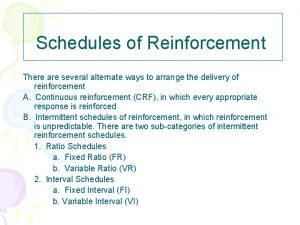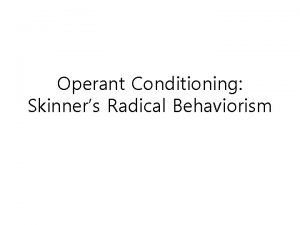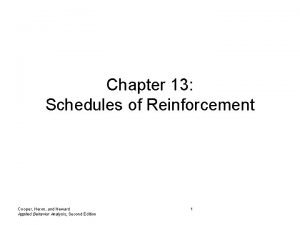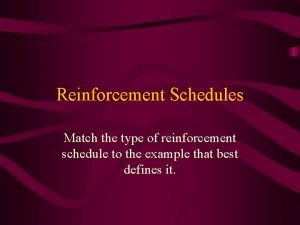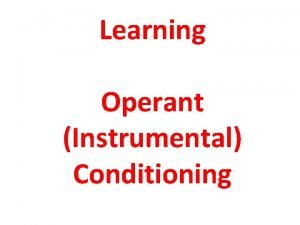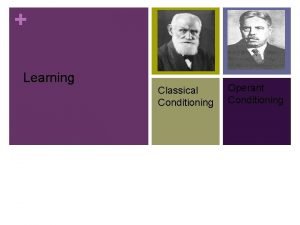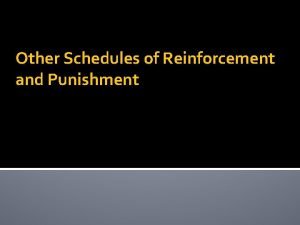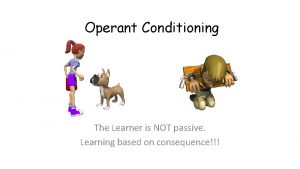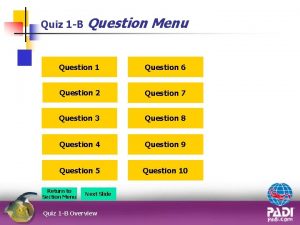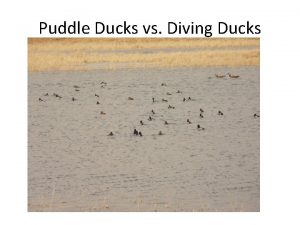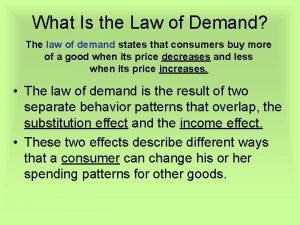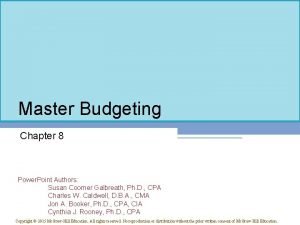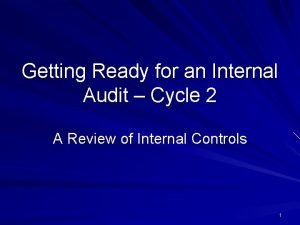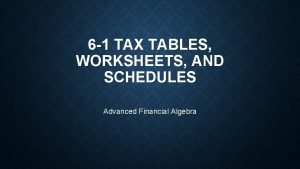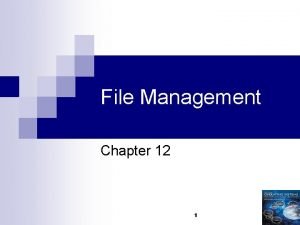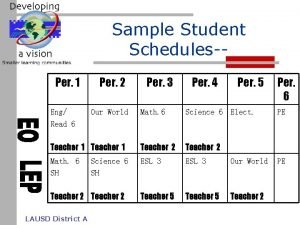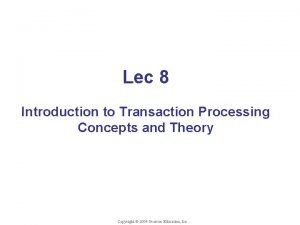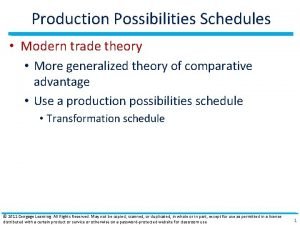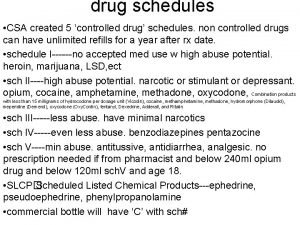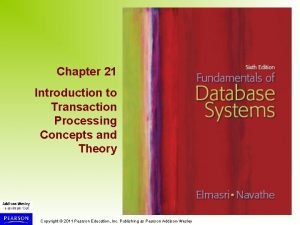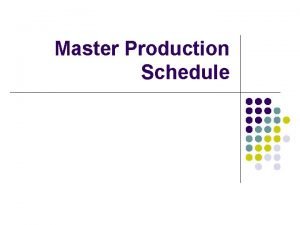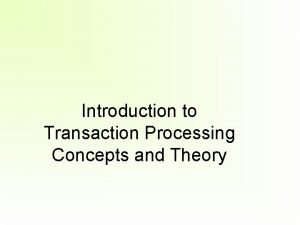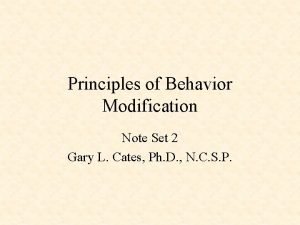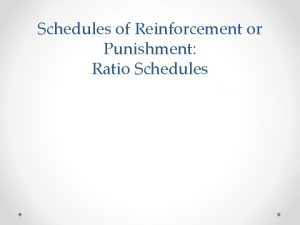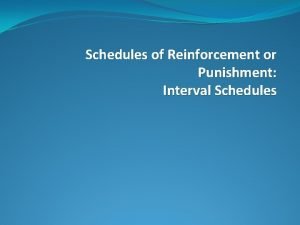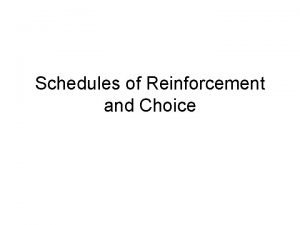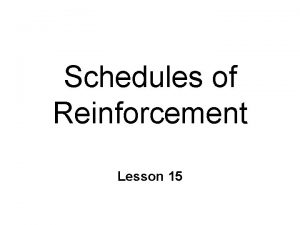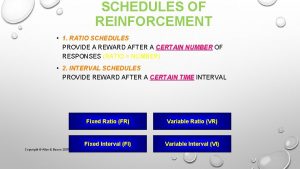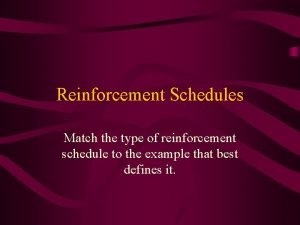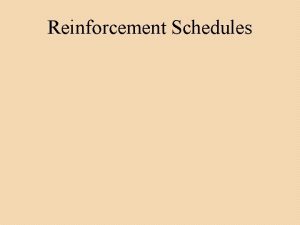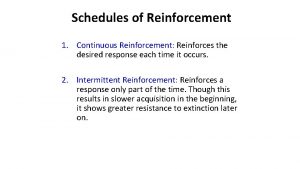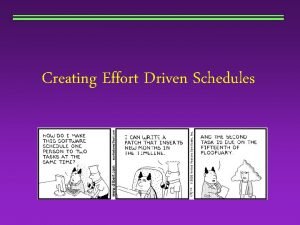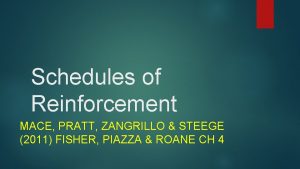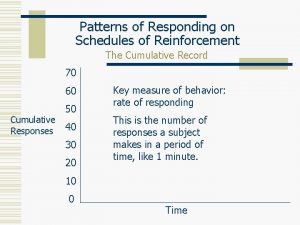Schedules of Reinforcement CH 17 18 19 Divers











































- Slides: 43

Schedules of Reinforcement CH 17, 18, 19

Divers of Nassau • Diving for coins • Success does not follow every attempt • Success means reinforcement

Intermittent Reinforcement • A reinforcer follows the response only once in a while.

Continuous Reinforcement (CRF) • A reinforcer follows every response. • Best used for shaping or maintaining difficult behavior.

Shaping with Reinforcement Behavior Initial: Andrew moves lips Intermed: Andrew makes croaking sound Before: Andrew has no gum Terminal: Says words clearly After: Andrew receives gum Behavior Initial: NA After: Intermed: Moves lips only Andrew receives no gum Terminal: Says words unclearly Extinction

Schedule of Reinforcement • The way reinforcement occurs because of the number of responses, time between responses, and stimulus conditions.

Schedules of Reinforcement • Ratio – Fixed Ratio (FR) – Variable Ratio (VR) • Interval – Fixed Interval (FI) – Variable Interval (VI)

Fixed Ratio (FR) Schedule of Reinforcement • A reinforcer follows a fixed number of responses.

FR Responding • After a response is reinforced, no responding occurs for a period of time, then responding occurs at a high, steady rate until the next reinforcer is delivered.

Reinforcers Reinforcement always immediately follows the 5 th response!!!! This is an FR 5 schedule of reinforcement. Pauses

Postreinforcement Pause (PRP) • The name for the pause after the consumption of the reinforcer and before the next ratio of responses begins.

FR & PRP • Length of the pause is proportional to the size of the ratio. • Small ratio – pausing is short • Large ratio – pausing is long

General Rule for establishing intermittently reinforced behavior: First use CRF and gradually increase the intermittency of reinforcement as responding stabilizes at a high rate.

FR 120 • What are the response requirements? • When will reinforcement be delivered? • What will the pattern of responding look like?

Cumulative Graph for FR Post reinforcement pauses Reinforcers

Variable Ratio (VR) Schedule • A reinforcer follows after a variable number of responses

VR Responding • VR schedules produce a high, constant rate of responding, with almost no postreinforcement pausing.

VR 50

VR 50 • Schedule notation • Number designates the average number of responses required for reinforcement

How do typical schedules of reinforcement differ from gambling? • See pages 290 -291

Skinner Box vs. 1 Armed Bandit Typical VR Gambling Schedule Many interspersed learned reinforcers No Yes Amount of reinforcer varies from ratio to ratio No Yes Small ratio No Yes Emotional reinforcers No Yes

Time Dependent Schedules • Fixed Interval (FI) • Variable Interval (VI)

FI Schedule of Reinforcement • A reinforcer is contingent on the first response after a fixed interval of time since the last opportunity for reinforcement.


Example: Fixed Interval (FI) Schedule of Reinforcement FI 200 -s 200 seconds 400 seconds 600 seconds

Fixed-Interval Scallop • A FI schedule often produces a scallop – a gradual increase in the rate of responding with responding occurring at a high rate just before reinforcement is available. No responding occurs for some time after reinforcement (Post Reinforcement Pause.

Example: Fixed Interval (FI) Schedule of Reinforcement FI 200 -s PRP Scallop 200 seconds 400 seconds 600 seconds

Lever Pressing of Mice after Training

Term paper vs. FI • Term paper does not have a deadline.

FI vs. Term Paper FI Term Paper Does early responding effect anything? No Yes Do you get more if you work harder? No Yes Is the relevant response class clear? Yes No Are there calendars and clocks? No Yes Is there a deadline? No Yes Is the reinforcer too delayed? No Yes

Fixed Time & Superstitious Behavior • Fixed time schedules of reinforcement – A reinforcer is delivered after the passage of a fixed period of time, independently of the response. • Superstitious behavior – Behaving as if the response causes some specific outcome when it really does not.

Superstitious behavior of the pigeon: Experiment by Skinner Fixed Time Schedule

Variable Interval (VI) Schedule of Reinforcement • A reinforcer is contingent on the first response after a variable interval of time since the last opportunity for reinforcement.

VI Responding • VI schedules produce a moderate of responding with almost no postreinforcement pausing.

Comparing/Contrasting Ratio and Interval Schedules • Pg. 305: table • Pg. 305: cumulative records

Continuous vs. Intermittent • CRF – every response is reinforced • Intermittent reinforcement – only some responses produce a reinforcer.

Intermittent Reinforcement • Makes the response more resistant to extinction than does continuous reinforcement.

Resistance to Extinction • The number of responses or the amount of time before a response extinguishes

Resistant to Extinction and Intermittent Reinforcement • Intermittent reinforcement makes the response more resistant to extinction than does continuous reinforcement. • Why? Hard for the rat to tell the difference between only an occasional reinforcement and no reinforcement • CRF followed by EXT: rats quickly stop responding: easy discrimination between reinforcement & extinction contingencies

4 Types of Concurrent Contingencies 1. Two compatible responses 2. Compatible contingencies for a single response 3. Incompatible contingencies for a single response 4. Two incompatible responses

Concurrent Contingencies • Contingencies that are available at the same time. • More than one contingency of reinforcement or punishment is available at the same time.

Concurrent Contingencies • Two levers in chamber – VI 300 s on Left lever – VI 30 s on Right lever • Will animal allocate more responses to the left or the right lever? • Matching Law (pg. 330) % of Left lever presses = % Left-lever reinforcers

Matching Law • Relative Frequency of responding on two concurrent schedules of reinforcement equals the relative value of reinforcement on those two schedules
 Fixed-ratio schedule example
Fixed-ratio schedule example Fixed ratio schedule example
Fixed ratio schedule example Schedules of reinforcement ap psychology
Schedules of reinforcement ap psychology Skinner's schedules of reinforcement
Skinner's schedules of reinforcement Concurrent schedule of reinforcement
Concurrent schedule of reinforcement Schedules of reinforcement examples with answers
Schedules of reinforcement examples with answers Variable reinforcement schedule
Variable reinforcement schedule Different types of reinforcement schedules
Different types of reinforcement schedules The process of acquiring through experience new
The process of acquiring through experience new Fixed ratio psychology definition
Fixed ratio psychology definition Learned helplessness
Learned helplessness Fixed ratio reinforcement schedule
Fixed ratio reinforcement schedule Operant vs classical conditioning
Operant vs classical conditioning Reinforcement schedule types
Reinforcement schedule types Compound schedules of reinforcement examples
Compound schedules of reinforcement examples Positive reinforcement psychology definition
Positive reinforcement psychology definition écrire un fait divers
écrire un fait divers Vanuatu coming of age tradition land divers
Vanuatu coming of age tradition land divers Divers who act foolishly at depth
Divers who act foolishly at depth Which of the following is a characteristic of puddle ducks
Which of the following is a characteristic of puddle ducks The pearl webquest answers
The pearl webquest answers Leisure meaning
Leisure meaning State the law of demand
State the law of demand Master budget schedules
Master budget schedules Internal audit cycle
Internal audit cycle Tax tables worksheets and schedules
Tax tables worksheets and schedules Directories pricing tables schedules and name list
Directories pricing tables schedules and name list Teacher schedules
Teacher schedules Gesell developmental schedules
Gesell developmental schedules Characterizing schedules based on recoverability
Characterizing schedules based on recoverability Camtran bus 9
Camtran bus 9 Creating production possibilities schedules and curves
Creating production possibilities schedules and curves Csa schedules
Csa schedules Bbc4 radio schedule
Bbc4 radio schedule Characterizing schedules based on serializability
Characterizing schedules based on serializability Master production schedule example
Master production schedule example Hep b vaccines
Hep b vaccines Banking company accounts schedules
Banking company accounts schedules Characterizing schedules based on serializability
Characterizing schedules based on serializability Secondary reinforcement psychology definition
Secondary reinforcement psychology definition Passive reinforcement learning in artificial intelligence
Passive reinforcement learning in artificial intelligence Bootleg reinforcement aba
Bootleg reinforcement aba Reinforcement lap lengths eurocodes
Reinforcement lap lengths eurocodes Differential reinforcement
Differential reinforcement

